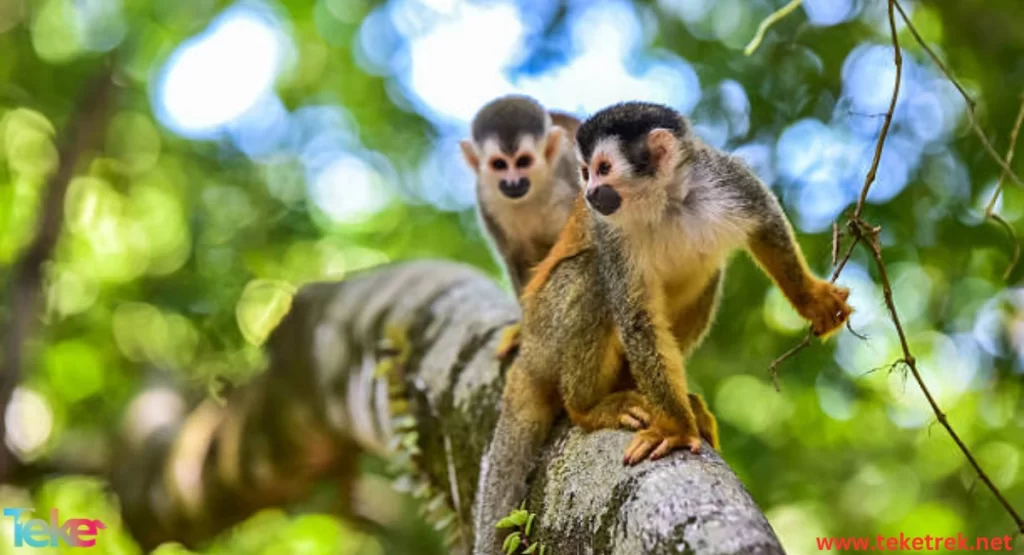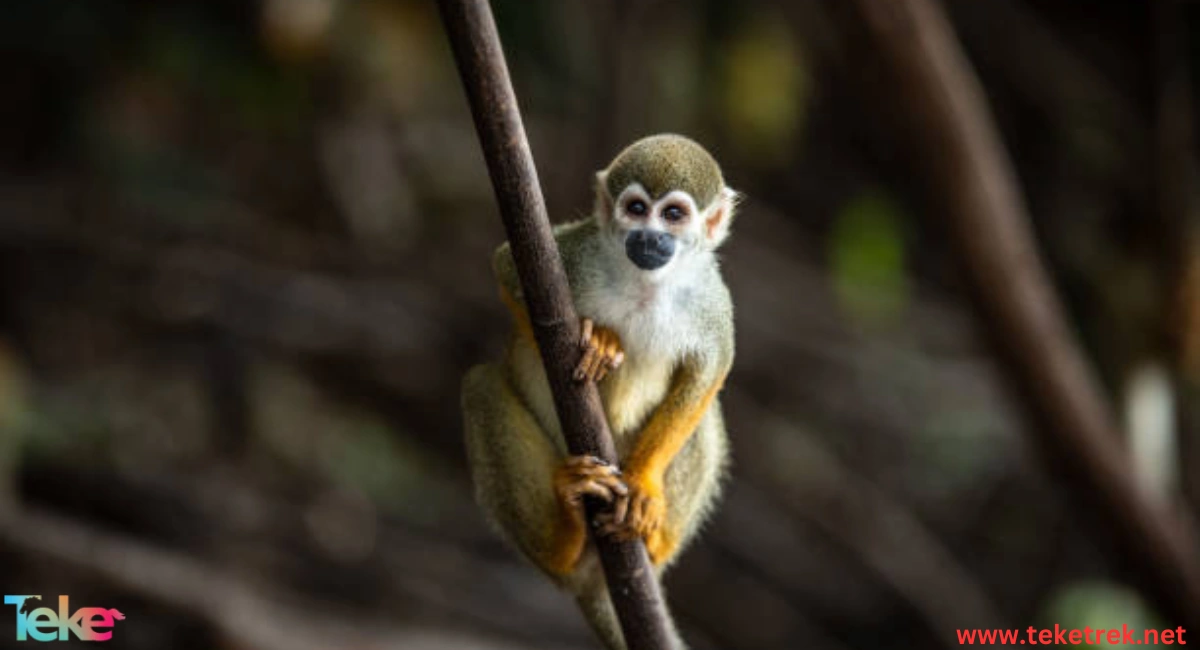Squirrel Monkey is considered one of the most commonly used animals in biomedical research in the United States, as its physical characteristics make it a valuable subject for research.
Let’s learn more about it from teketrek.
The Squirrel Monkey specification
The face: It is characterized by a circle of hairless black skin around its nose and mouth, with a white face.
The fur: The squirrel monkey has a short, soft fur that is gray to olive green in color, with white undersides.
The Squirrel monkey height: The length of the squirrel monkey ranges from 25-40 cm, not including the very thick, sturdy tail, which is at least as long as the body and helps with balance.
The mass: The average body mass of male squirrel monkeys ranges from 700 to 1000 grams, and in females from 500 to 750 grams.
The color of hands, arms, feet, crowns: The hands, arms, and feet of the squirrel monkey are colored yellow to orange, and they also have olive or gray crowns.

The behavior of the squirrel monkey
The squirrel monkey is among the loudest primates in the forest, communicating with at least 26 to 35 different and unique sounds for squirrel monkeys.
They use sound to communicate across forest habitats, including barking, chattering, and screaming.
The squirrel monkey is aggressive and extremely agile.
Squirrel monkeys prefer life in trees, although they sometimes come down to the ground.
Diurnal organisms, so they are most active during the day.
They move as a single troop led by their leader along frequently used paths in the treetops, and at night they sleep together with tails wrapped around their bodies.
It is the playful little acrobat that we see in the zoo, reaching out its hand for a piece of food or a peanut that it loves.
The squirrel monkey is known for its intelligence and agility, with various species ranging from very small to large, cute, and fierce.
Dwarf Mongoose: Fascinating Facts and Behavior of the Smallest Mongoose
Squirrel monkey habitat
Squirrel monkeys live in the Americas, specifically in eastern Colombia and northern Brazil.
They are usually found in tropical forests and live-in groups of 10 to 80 individuals, sometimes even up to 100.
What are the subspecies of squirrel monkeys
Saimiri Orestidi
Saimiri Sirius
Saimiri Ostos
Saimiri Polivini
Saimiri Vanzolini
Squirrel monkey diet
The squirrel monkey is considered an animal comnivores , meaning that it feeds on both plant and animal matter, including flowers, fruits, leaves, insects, as well as small vertebrates and even eggs.
At times, squirrel monkeys also feed on tree buds, gum, and spiders.
Desert Long-Eared Bat: Adaptations and Behavior of a Unique Desert Dweller
Reproduction stages in squirrel monkeys
Adult male squirrel monkeys, aged three years, mate with one female, who becomes the mother of their offspring.
The male squirrel monkey builds a separate nest with her and shares in caring for the young.
Some monkeys mate covertly with more than one female, without emitting loud sounds to attract females, fearing exposure or being attacked and expelled from the group.
The paired individual is not well-liked among members of their tribe.
Squirrel monkeys only mate during the dry season over a period of two months.
Pregnant females within a group typically give birth within a week of each other..
The female gives birth after a gestation period of 6 months.
The infant monkey rides on the mother’s back in the first few weeks of its life and remains dependent on the mother for about a year.
This means that young monkeys can be weaned at the beginning of the rainy season when most food is available.
The juvenile monkey clings to its mother’s forehead in the first two weeks of its life and then starts clinging to her back
A squirrel monkey reaches full maturity at 16-24 months of age.
Females in a group without their own young may assist in caring for the offspring of other mothers by carrying them or even nursing them.

FAQs about squirrel monkey
How long do squirrel monkeys live?
Squirrel monkey lifespan can extend up to 20 years.
What are the signs of aggression in squirrel monkeys?
Grinding teeth and pulling lips are signs of aggression in squirrel monkeys, along with yawning, head tilting, head shaking, and shoulder shrugging.
- What are 5 interesting facts about squirrel monkeys?
Unlike some other monkey species, squirrel monkeys have non-prehensile tails, meaning they cannot use their tails to grasp objects.
Squirrel monkeys are diurnal, which means they are active during the day, much like humans.
They are known for their high intelligence, having a relatively large brain compared to their body size.
Squirrel monkeys have distinctive facial markings that make them easily recognizable.
They live in social groups and exhibit complex social behaviors, including cooperation and communication.
- How do squirrel monkeys sleep?
At night, they sleep huddled together on branches, tail wrapped around their bodies. Squirrel monkeys and capuchin monkeys often forage together, feeding on a diet that includes fruit, leaves, buds, tree gum, insects, spiders, and small vertebrates.
- Are squirrel monkeys peaceful?
Costa Rica’s squirrel monkeys are known for being among the most egalitarian and least aggressive primates globally.
- Are squirrel monkeys intelligent?
Squirrel monkeys are highly intelligent, possessing the largest brain-to-body mass ratio of any primate.
- Is a squirrel monkey a good pet?
Yes, it is a good pet.
- Why are they called squirrel monkey?
Because their tails are long.
In conclusion, it is important to highlight the importance of protecting the Squirrel Monkey and making great efforts to prevent their extinction.
References:





